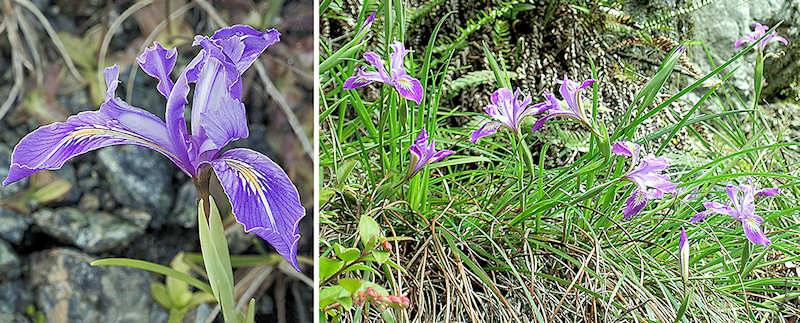Wild PCN iris - four unique species:
4. Thompson's iris - Iris thompsonii

Iris thompsonii: (L) © Bill Bouton, Jed Smith State Park, Del Norte County, California; May 23, 2010; (R) Diane Whitehead,
Smith River canyon, Del Norte County, California.

Range: Lower regions in the Klamath Range of Del Norte County in northwestern California and southwestern Oregon. 90 to 600 meters (300 to 2,000 feet) elevation.
Original material: Douglas Park on the Smith River, Del Norte County, California, by J.W. Thompson, 1928.
Key identifying features:
- Floral tube slender, funnel-shaped at top, medium length (around ¾ inch).
- Spathes short, broad and closed around ovary.
- Ovary triangular in cross section.
- Flower parts rather broad and rounded.
- Numerous flowers on each mature clump.
- Leaves very slender, grass-like, dark glossy green above, lighter matte below, long-lasting.
- Mature plants form dense, compact evergreen tussocks.
Flower color: Pale lavender to violet purple, occasionally white or gray.
Habitat: Open hillsides, sunny meadows or other exposed sites on lightly shaded slopes; fir / pine forests; well-drained soil.
Name: By Robert C. Foster, after John William Thompson, Seattle-based botanist and collector of the original specimens along the Smith River.
Comments: Thompson's iris has long been considered a variable hybrid population - the product of repeated crosses between Iris innominata and Iris douglasiana. We follow here the second edition of The Jepson Manual: Vascular Plants of California (2011), where it is treated as a distinct, independent species.
Recent genetic evidence suggests that Thompson's iris is most closely related to Iris innominata, with which it shares many traits. Some workers believe the easiest way to identify a Thompson's iris is to look for a Golden iris with lavender or purple, rather than yellow flowers. If this proves reliable, the actual distrbution of Iris innominata in the Klamath Range of southwestern Oregon will need to be reevaluated - and it may not extend into northern California at all. Specimens once cataloged as "purple or lavender Iris innominata", or "Del Norte County Iris" might turn out to be Thompson's iris.
The presence of iris plants in the same coastal Oregon-California border regions, with evident douglasiana X innominata X thompsonii features, should make future studies an interesting challenge.
Species or Hybrid?
For contrasting views on the taxonomic status of the name thompsonii, you can check two articles by Carol Wilson: "An investigation into the status of Iris thompsonii (Iridaceae)" (Madroño, Vol. 37:113-123, 1990), and "Phylogenetic relationships in the Iris series Californicae, based on ITS sequences of nuclear ribosomal DNA" (Systematic Botany, Vol. 28:39-47, 2003); and one by Nelson Young: "Concordance and discordance: a tale of two hybrid zones in the Pacific Coast Irises (Iridaceae)" (American Journal of Botany, Vol. 83:1623-1629, 1996).